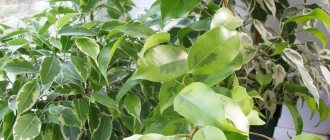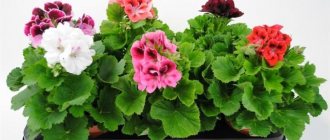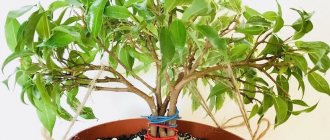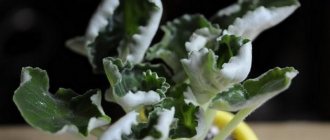More than 50 species of this crop are used in indoor floriculture! You can choose a plant that is compact or tall, of different types of growth, with wide large glossy or thin small leaves, with different colors, shapes and sizes of leaf blades on short or long petioles...
But it’s not always that a bright bush with a dense crown brought from a store or greenhouse will feel good in a new place. Thus, many owners of one of the most popular types of ficus, Ficus Benjamin, complain that their leaves “slightly” turn yellow and fall off en masse. Owners of ficuses with hard, leathery leaves (rubber, microcarpa, etc.) sometimes notice that they begin to lose turgor, wither or dry out at the edges and tips. Sometimes the problem does not end with darkening and flying leaves - then the branches and even the ficus stem dry out.
What troubles and why can happen to your favorite indoor plant? And most importantly, how to eliminate their causes and return the ficus tree to its former decorative properties? Let's figure out together why the ficus dries out or flies around in the apartment.
Reason #1. Abrupt change in conditions
Some ficus plants are simply very capricious in terms of changing growing conditions.
Of course, each type of ficus has its own requirements for living conditions, but there are also “record holders for capriciousness.” The main “picky” plant in this regard is the already mentioned Ficus Benjamin, which reacts with massive leaf fall to literally any changes.
Ficus growers even joke about this: “If you bought a Benjamin ficus, then you don’t need to ask whether it will shed leaves in your apartment, you need to ask exactly when and how quickly it will do it.”
The light from the window became brighter in the spring, or you opened the window wide, turned the radiators on or off (changing the air humidity), in the fall it became cooler in the apartment, the child carelessly touched the plant while watering, or you moved the pot to a nearby window sill for convenience - and here is a tree, which just pleased you with its lush openwork crown of variegated leaves, stands almost bald.
The same demanding ficuses include ficus sacred, ficus rough, ficus equifolia, ficus Palmer, ficus microcarpa.
In most cases, having become a little angry at the careless owners and being left alone, such a plant will soon grow into foliage again. But not always.
So if you are the owner of an apartment where the windows are constantly open and there is a draft, children and animals run around, touching the plants, you often forget to water indoor flowers on time or regularly rearrange them around the room - maybe you just need to replace the “whims” with more unpretentious ones and resistant to change representatives of the clan? For example, rubber ficus, lyre-shaped ficus, willow ficus.
How to save rubber ficus. Ficus rubber plant dies
Good afternoon. We really need your help. The rubber ficus dies. 40 days ago we bought it in a store, two days later I took it out of the pot, freed the roots from the soil, replanted it in universal soil, where I added swagnum and black coal. I placed drainage at the bottom. I watered it three days after transplanting. I water as the top layer of soil dries. I try the soil with my fingers. Literally a few days later the bottom leaf fell off, then the leaves began to fall off one by one, turning a little yellow. The last leaf fell off today, before it even turned yellow. The leaves drooped, the trunk wrinkled. The bottom became dark and acquired the color of decay. It feels hard to the touch, but not as hard as the top of the barrel. At first I thought that I would get over the illness and everything would be fine. But now I understand that I’m doing something wrong. When I took the plant out of the ground during transplantation (a month ago), the roots were wrapped in a proclamine package containing soil and white powder. I removed everything, trying to be very careful with a stick. The roots were completely cleared of soil. They seemed good and bright. I dried it for 10 minutes. Now every morning I'm afraid to look at him. I placed it on the closet next to the window. Direct rays do not hit. But before that I changed places several times, trying to understand what was best for him. I try not to touch it so that the leaves don’t fly off. I really like this flower, I have long dreamed of having one like this. Please help me cure him, if it’s not too late.
Reason #2. Heat and dryness
This is perhaps the most obvious reason why ficus leaves can dry out.
Most representatives of this genus require a fairly cool ambient temperature (especially in winter, and usually not higher than 20-25°C in summer), constantly moderately moist soil, and mandatory regular spraying of the crown or wiping the leaves with a soft damp cloth.
Ficus small-fruited, ficus lyre-shaped, rubber-bearing ficus, ficus natalis, ficus sagitta, ficus microcarpa, ficus dwarf are in great need of humidity “from above and below”, as well as in the absence of dry heat.
Direct sunlight, dry air and soil, underwatering, placement near heating sources in winter - all this is almost guaranteed to lead to withering and drying out of the leaves and young shoots of such plants. In this case, leaf blades often begin to dry from the edges or tips.
Why do ficus leaves turn yellow and fall off en masse?
Experienced flower growers point to 8 reasons why Benjamin can drop almost all of its leaves:
- Moving, especially to worse conditions or sharply different from those to which the ficus is accustomed. For example, from the nursery to the apartment, from one room to another, from the windowsill to the interior of the room.
- Transplant into a new pot with a new substrate.
- Drafts, especially after spraying the plant or bathing it in a warm shower.
- The air is too hot or too dry.
- Lack or excess of sunlight.
- Over or under watering.
- Pest attack.
- Lack or excess of mineral fertilizers, unsuitable soil.
Reason #3. Overflow
You may be surprised, but for ficus plants with thin leaf blades, overwatering can be just as unpleasant as underwatering!
The same ficus Benjamin, equal-leaved, sacred, dwarf and even rubber-bearing ones will persistently “demand” stable humidity from the owner. Do you transfuse regularly? Got dampness in the pot? Did you pour water at the wrong temperature? Receive yellowing, darkening and leaf drop.
Regular overwatering can even lead to rotting of the roots - you understand, the above-ground part of the plant after this is unlikely to be healthy and decorative, the leaves will begin to wither and fall off.
But, for example, the wall ficus is not so capricious - at least it will tolerate a single severe drought or waterlogging without much damage to itself.
There are also ficuses that require completely different conditions at different times of the year. So, figs (yes, this is also a ficus, though it is deciduous!) in the summer during the growing season will require abundant watering from you, but in the winter during the dormant period it will require very, very moderate watering, as long as the soil does not turn into stone or dry dust.
Fungal diseases
Gray rot
Such a disease can be detected simply by examining it. A characteristic sign is mold throughout the plant. It is capable of dusting not only the leaves, but also the branch and trunk, acts like ordinary dust, and is easily shaken off at the slightest contact.
Infected areas become dark and die over time. A favorable environment for the development of gray rot is dampness and warmth.
You can overcome this disease by removing the affected areas and drying the soil. It is also necessary to reduce the amount of watering and ventilate the room more often.
Sooty mushroom
A gray or black coating forms only on the foliage.
Appears in the presence of aphids, scale insects and similar pests when they secrete sticky mucus.
In this case, you need to eliminate the contaminated area or treat it with a solution of soapy water using a sponge.
Then spray the entire flower, right down to the roots, with the funkicide solution.
Powdery mildew
It has all the same symptoms as sooty fungus, only it differs in a white coating on the foliage, which is easily washed off in the initial stages of the disease with a solution of laundry soap. If the stage is more serious, the affected areas are removed.
Cercospora
Dark spots that spread along the underside of leaves. The disease originates and develops in the Cercospora fungus in waterlogged air. The spots gradually grow throughout the plant, after which the leaves dry out and fall off; in some cases, the ficus may not be saved.
This problem can be solved by spraying with antifungal drugs, after removing the diseased leaves.
Anthracnose
Infection with anthracnose has almost the same symptoms as cercospora. Only in addition, wounds also form on the edges of the leaves.
You can also get rid of this disease with antifungal drugs.
Root rot
The usual process of rotting of the root system is caused by an excess of soil moisture. In this case, the ficus has little chance of life.
To prevent this disease, water with a weak solution of potassium permanganate no more than once a month.
Reason #4. Light too bright or dim
As we have already mentioned, some ficus plants are exclusively shade-loving plants. Being suddenly exposed to direct sun or constantly being on the brightest windowsills, they will feel unwell, responding to this “attitude” towards themselves, including discoloration and drying out of the leaf blades, and even getting real sunburn.
Such plants include, for example, ficus sacred and ficus wall. The rubber ficus also adapts well to lighting.
But figs, ficus Benjamin, ficus lyreform, ficus microcarpa, rubber ficus, petiolate ficus, dwarf ficus, ficus binnendijka (willow leaf), on the contrary, love “stable” light places - but for them, light, even bright and plentiful, will be more acceptable, but scattered, not direct. In these species, on the contrary, it is excessive darkening that can cause the leaf blades to darken and fall off (usually starting from the lower ones).
- Ornamental plants for a shady balcony: list with photos Plants for shady places can be no less decorative and bright than light-loving crops.
Other spots
Botrytis forms large rusty spots with concentric rings. Tiny, slightly raised, dark green or red formations on the lower surface of the leaves are the main symptoms of the disease described. Corynespora spots may appear on young shoots in the form of large reddish dots. There are several other fungal diseases that equally often affect ficus plants. Cankers caused by fungi are crusty lesions that can girdle and kill shoots.
The fungus Sclerotium rolfsii causes rot, white cotton mycelium with such infection grows not only on the stems, but also on the leaves of plants and causes their death. There is no chemical prevention or treatment for this problem. If the ficus is covered with such spots, it must be destroyed. All bacterial diseases are fatal. Agrobacterium tumefaciens causes slightly swollen areas on infected leaf veins, stems or roots. Xanthomonas starts out as tiny water-soaked spots on the foliage. They enlarge quickly and may have bright yellow edges. In this case, it is possible to use bactericides.
See below for proper care of ficus trees.
Reason #5. Cold
Remember - comfortable, cool conditions for growing ficus trees do not at all equal the concept of “needing cold.”
Even the most shade-tolerant and heat-averse ficus plants will react to hypothermia of the roots, including drying out and falling leaves. This is especially dangerous when coupled with regular overwatering, when the roots not only get too cold, but also begin to rot. And such hypothermia, for example, can occur already at temperatures below 16-18°C.
This may also be relevant for potted crops that stand on a cold (for example, stone) floor or windowsill, where drafts are frequent. An option to correct this situation is to place a felt, wooden or foam “backing” under the ficus pot.
In any case, before purchasing this or that ficus, be sure to study its requirements for living conditions - including temperature!
It turns black, withers, disappears - what can be done?
Sometimes ficus leaves can turn black, what does this mean and how to solve this problem?! The plant needs constant and proper care; if the necessary conditions are violated, the flower gets sick and withers.
Leaves turn black for several reasons:
- Excess water in the soil leads to such consequences; it is necessary to reduce watering if it is reliably known that the leaves have turned black for this reason.
- All types of ficus categorically cannot tolerate drafts. Keeping the plant in a draft can lead to blackening and falling of the leaves, even to the death of the flower.
- Too much lighting in the room in which the plant is kept can negatively affect the condition of the ficus; in this case, the plant reacts by turning the leaves black and falling off. A lack of light can also manifest itself in this way. It is necessary to carefully select a place for a flower so that the lighting is acceptable, and you do not have to move the flower pot to another place, since this is additional stress for this plant.
- Temperature conditions may well affect the appearance and general condition of the plant. The correct temperature regime must be maintained regularly, without changes or failures, because this does not have the best effect on the ficus. In winter, if the room temperature drops below 18 degrees or rises above 20 degrees, this can also cause darkening of the leaves.
It is quite possible to correct this problem; to do this, you need to create the necessary conditions for the plant, and it will immediately react properly, become beautiful and strong.
Reason #6. Soil depletion
Ficus foliage can weaken, turn yellow, dry out and fall off for another obvious reason - the plant lacks nutrition.
Ficus does not require frequent regular heavy feeding, but any soil becomes depleted over time, so from time to time it would be a good idea to feed this unpretentious plant with liquid complex fertilizer.
Oddly enough, if the tips of the leaves of a plant regularly dry out, the opposite situation is also possible - you are overfeeding it!
It is also possible that the ficus “sits” for years in a small pot without moving it - and it lacks not only fresh nutritious soil, but also, in principle, space for the root system. There can be no talk of good health here.
- How to feed indoor plants - choosing the ideal fertilizers for flowers on the windowsill Do you want your plants to delight you with their healthy appearance all year round? Then create the right feeding regimen for them!
Needs and consequences of care errors
At home, you can most often find the following varieties of ficus:
- Benjamin;
- rubbery;
- lyre-shaped;
- microcarp.
Basically, these plants require the same care, but there are nuances.
First of all, you need to pay attention to the lighting - whether the plant has enough sunlight. This is especially true for large-leaved varieties - lyre-shaped and rubber-bearing. Ideally, their leaves should be dense, leathery, shiny, and without spots.
If there is not enough light, the ficus sheds its leaves, they fall off, starting from the trunk, what to do:
- urgently find a place near the window;
- wipe the leaf plates from dust or arrange sprinkling for the plant;
- feed with nitrogen fertilizers.
If the plant has white spots, that is, a variegated form, it needs even more ultraviolet radiation. Even 3 days in partial shade can weaken the immune system and harm the crop.
The second important factor is watering. A strict schedule is not applied in this case, since the speed of soil drying depends on many factors. You need to check this: if you dig your finger 3 cm into the soil and it doesn’t get dirty, then the plant needs watering.
Another problem is excess moisture, especially in the cold season, when the flower is dormant and does not consume liquid. If the ficus leaves begin to turn yellow and fall off at the same time, it is necessary to analyze whether the plant was in a cold room. Perhaps its root system has begun to rot. What to do if the ficus leaves fall and turn yellow in spring or winter:
- remove the root and inspect for rotting;
- rinse and remove damaged parts;
- disinfect with antifungal drugs, let dry;
- take a new pot and new soil (do not use the old one), replant.
The soil should be minimally moist. This is the only way to save the ficus.
Ficus grows poorly
If a flower does not gain enough green mass, in other words, it grows poorly, the reason may be the following:
- overwatering the plant - the roots do not breathe, so metabolism is disrupted;
- lack of lighting, little chlorophyll is formed;
- poor soil, insufficient nutrition.
Most often, these factors work simultaneously, because gardeners do not pay enough attention to indoor crops or do not know their needs.
Plants, not just ficus trees, can get sunburned in the spring if they are placed in direct sunlight. In this case, the “attention” of the flower will be directed to healing wounds, and not to growth and development. The crop may even become infected with fungus.
East and west windows are most suitable for a permanent flower location.
Leaves falling for no apparent reason
One of the reasons why ficus leaves turn yellow and fall off may be a lack of nutrients in the soil. If the plant is old and large, replanting it is quite problematic due to its size.
In this case, nutrition must be added regularly, especially during the period of active growth of green mass - in spring and summer.
Ficus plants need nitrogen and phosphorus most of all at the beginning of the growing season. This accelerates the growth of the root system and makes it possible for foliage growth. Since ficuses do not bloom at home, potassium is not so important for them, although this microelement is involved in many life processes and it is necessary to add it.
If there is not enough potassium, the plant will expel new leaves, but the old ones will fall off.
Important! Potassium does not work if there is a lack of phosphorus. The same goes for nitrogen.
Reason #7. Ficus got sick
Root rot, sooty fungus, cercospora blight, anthracnose, botrytis are diseases that your ficus can “catch” if not properly cared for.
Along with all other signs, the presence of a fungal or bacterial pathogen can also be indicated by dry and weeping spots on the leaves, blackening or yellowing, falling, wilting and drying out of foliage, stems and branches.
To prevent this from happening, study the signs of possible ficus diseases, regularly inspect your plants for their appearance and, if necessary, take appropriate measures - from preventive treatments to plant replanting.
Infections and fungal infections
Proper care will keep any plant healthy. But sometimes even he is not able to get rid of unwanted problems that arise due to the diligent care of the gardener. Ficus diseases also occur due to external factors: initially hidden diseases in newly purchased plants, cuttings, when replacing the soil mixture or transplanting into open ground.
Infections and fungal infections of ficus
The most common diseases of any type of ficus genus include:
Powdery mildew
White spots that look like a fluffy coating that are easily erased.
Reason: from direct sunlight, places damaged by insects, subsequently infected with fungus. Treatment: The plaque is washed off with a sponge soaked in soapy water. Severely affected leaves are removed. The plant is treated with a fungicide.
Anthracnose or rust
Uneven, rusty spots with a brown border along the edge of the leaf. After some time, holes form in their place. Later the leaves completely darken and die. Cause: Fungus Colletotrichum orbiculare. Treatment: Diseased areas are cut off, the ficus is treated with fungicide and copper oxychloride.
Cercospora
Small brown or black dots at the bottom of the leaf, which gradually increase in size. After a couple of days, the leaf withers and dies. Reason: Dampness, waterlogging in the room. Infection with a fungus of the genus Cercospora. Treatment: spraying with a fungicidal preparation.
Botrytis, gray mold or mold
Foliage with a gray coating. If you shake it, dust consisting of tiny fungal spores rises into the air. As the disease progresses, brown spots with a dark halo appear. Soon the leaf darkens and falls off the stem. Cause: Increased temperature and humidity. Infection with the mold Botryotinia fuckeliana. Treatment: Treatment with insecticides, fungicides and removal of infected parts.
Root rot
Wilting, gray foliage. Rotting of the base of the stem and root system. Reason: Strong overflow. Root damage by fungal spores. Treatment: Doesn't exist. It is recommended to discard the plant.
Sooty mushroom
The leaves become covered with a gray or blackish coating, similar to soot, and emit a rotten smell. Cause: Sticky secretions of insects with simultaneous infection by a fungus that feeds on these waste products. Treatment: Wash the plants with soapy water. Removing infected leaves and treating with a fungicidal solution.
Reason #8. Ficus was attacked by pests
The situation is the same with pests - aphids, nematodes, scale insects, thrips, mealybugs, yellow and red spider mites can settle on the ficus and harm the plant by sucking out its juices.
As a result, the crop weakens, the above-ground parts lose turgor, the leaves and shoots become covered with holes and spots of various shapes and sizes, dry out, wither, and fall off.
If appropriate measures are not taken and pests are left to multiply uncontrollably, this can even lead to the death of the plant.











